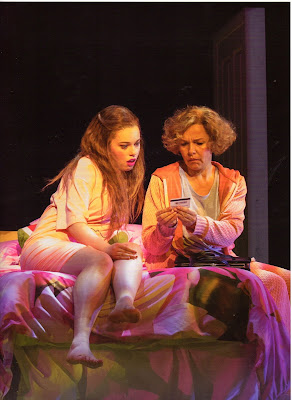Choreographer: James Batchelor
Performers: James Batchelor, Chloe Chignell/Amber McCartney
Visual Artist: Annalise Rees
Sound Design: Morgan Hickinbotham
Reviewed by Frank McKone
Deep was the space of the empty black stage of the Canberra Playhouse. Deep the performances must have been for the creator and performers. But little was meaningful to me, even though I could walk around respectfully with the other several dozen observers for very close-up or more distant angles of view.
I describe the work as a literal exercise of the imagination: intense and mostly oh-so-slow exercise on the performers’ parts, while my imagination was working flat-out trying to make anything out of what they were doing.
Having read that this was the result of Batchelor’s and Rees’ trip on an Antarctic marine research vessel, I thought I saw some movements reminiscent of the sea sway I had experienced on the good ship Otranto for 36 days (London to Sydney in 1954). I also saw some some oddly shaped white pieces of board they used to roll a little ball around on, which might have represented icebergs.
Unfortunately that made me see the rest of my crowd as a “colony, a rookery or a Waddle” of penguins [see http://www.penguins-world.com/what-do-you-call-a-group-of-penguins/ ], which rather defeated the apparently serious purpose of the performers, who became for me tourists disrespectfully disturbing the penguins who were forced to move away and regroup as their space was invaded.
The rolling of balls became some sort of theme, from the two they tossed off the stage near the beginning, which were retrieved towards the end; the large plastic blown up beach ball which the woman rolled up and over the man; the little ball rolled around and then off one “iceberg” to the other (and which mysteriously disappeared); and the row of little balls the woman carefully placed along the spine of the man (lying on his front) which with extraordinary flexibility he made roll from his lower back to between his shoulders and back again, and forward again and off over one shoulder. One of these was then picked up between the woman’s two index fingers (on separate hands) and slowly rolled around each finger (amazingly without being dropped) while the man used a small mirror to reflect a beam of light from an above stage spotlight onto her ball, which she eventually raised and moved until she stuck it in her ear.
Somewhere in this activity must have been the intention which James Batchelor explains as follows: “The expedition was an environment where art and science as research were occurring simultaneously. What then is the relationship between art and science? How do these practices contribute to or interrogate one another? What are the potential platforms for art and science to engage with people today and in the future? These are ongoing questions that Deepspace is concerned with.”
[ http://james-batchelor.com.au/projects/deepspace/ ]
Having seen Deepspace, those questions remain ongoing.
However one aspect of the performance interested me, following my interest in my teaching days in Rudolf Laban [ see https://en.wikipedia.org/wiki/Rudolf_von_Laban if you need to get a good picture]. In my interpretation, Laban’s work showed how movement, especially between two people, can form its own kind of ‘movement grammar’, so that each position seems to have been a natural result from the previous position, and can be followed naturally to the next position. It’s rather like two people having a conversation in the same language: you respond to what I say, and I respond to what you said. A sentence might form this way (a series of movements initiated by one person) but significantly a kind of mysterious wholistic conversation can happen; which in movement can incorporate many more performers than just two.
At the beginning of this kind of work, it will be improvisation, but the result can be a dance which may look quite fascinating to watch. The meaning, though, can be apparent only to the dancers who have brought this unique language into being.
Whether consciously or not, this is what James Batchelor and his Collaborators have done. Some among the observers remained apparently transfixed until the nearly 70 minute end; others remained polite but bemused; because I had read that in Melbourne it had run for 40 minutes, I became more distant – if not entirely bored – after that time, until the ball bearing episode took my attention near the end; no-one walked out as far as I could see (which wasn’t always very far between the penguins).
So I leave you with ongoing questions, not only about how art and science relate, but even about this particular example of performance art.
Since no program or media material was provided at the show, I acknowledge the two following images:
 |
| Contemporary dancers James Batchelor and Amber McCartney in 'Deepspace'. Photo: Jamila Toderas |
by Bree Winchester: http://www.canberratimes.com.au/act-news/canberra-life/subantarctic-trip-inspires-new-work-from-canberra-choreographer-james-batchelor-20171220-h08bxt.html
 |
| James Batchelor with 'iceberg' realtimearts.net |






























